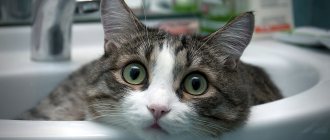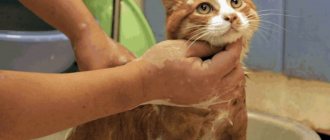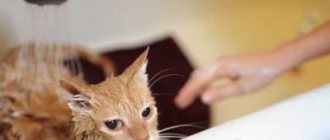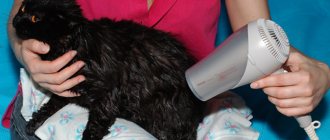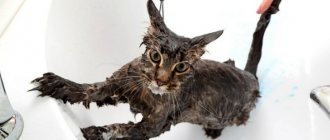How often can you wash your cat?
Cats do not need to be washed daily or weekly; bathing once every 2 months is considered normal.
Watching the cat, it is easy to notice that in her free time from playing and feeding, she likes to “preen” - licking her fur, paws and tail. The animal keeps its fur clean on its own, so it does not need regular bathing. Moreover, too frequent washing can harm the cat, as the pet's subcutaneous glands produce a protective lubricant. The substance is distributed throughout the coat, makes the hair silky, and also serves as a barrier against bacteria. Interesting fact: cats and cats groom themselves differently. Cats spend more time licking their fur and do it more thoroughly than males.
It is important to distinguish between thoroughly washing the cat with shampoo and wiping individual areas of the coat as it gets dirty. If the cat got dirty in the toilet or came home from the street, wipe off the dirt with a soft cloth previously moistened in warm water. This will not harm the pet.
You need to teach a kitten to wash from the age of 4-5 months, so that bathing becomes a habitual ritual, and, as an adult, he would not experience fear of water. In any case, you will have to wash your domestic cat throughout its life, because its fur gets dirty and matted, and you really want the “fur coat” to always be luxurious and well-groomed!
What can and cannot be used to wash a cat?
You can wash cats only with special pet shampoos, and choose them in accordance with the breed and coat type of your pet. Soap or regular shampoo is absolutely not suitable for cats. Products for humans are more aggressive; they contain surfactants and other active substances that can cause disruption of the sebaceous glands, dry skin, and dandruff in cats.
How to wash a kitten?
It is better to bathe a kitten no earlier than he is 3-4 months old. Until this time, his mother takes care of his hygiene. For washing, choose shampoos approved for kittens.
In some cases, for example, if the baby is bothered by parasites, the kittens are washed with special antiparasitic agents. To get rid of fleas, you can wash the kitten in a saline solution (1 tablespoon of salt per glass of water) or in an infusion of wormwood.
Insecticide shampoos
Medicinal shampoos contain active substances that destroy fleas and can rid your cat of them in a short time. You can wash your cat with insecticidal shampoo no more than once every two months and only when indicated, since chemicals negatively affect the condition of the coat, and in addition, can gradually accumulate in the body, causing poisoning.
From what age can it be used?
There are quite a few anti-flea shampoos that can be used on kittens over 8 weeks of age. Some manufacturers produce products that can be used starting from one month of age. In any case, before washing a kitten with shampoo, you need to find in the instructions an indication of the permitted age.
Bathing with shampoo as a flea prevention
You can wash your cat with preventative flea shampoos much more often than with therapeutic ones, since they do not contain toxic insecticides. To protect against fleas, herbal shampoos are used, which contain natural ingredients - plant extracts and essential oils that repel insects.
But, despite the safety, it is not recommended to frequently wash your cat with flea shampoo; it is better to additionally use another means of protection, for example, a flea collar.
When should you bathe a cat?
It is necessary to bathe a cat only if there are good reasons for doing so. Indications for washing your pet:
- More than 2-3 months have passed since the last bath, and the cat’s fur has become dull, darkened, and matted;
- the cat is very dirty, for example, rolled in the mud or covered in paint;
- If parasites are found in the fur, you need to immediately bathe the cat and then treat the “fur coat” with an antiparasitic agent. You should especially carefully examine cats that are often outdoors and can “catch” ticks and fleas;
- washing may be recommended by a veterinarian if a cat develops allergies, lichen, dermatitis and other skin-related diseases;
- if you find a kitten on the street and decide to take it into the house, then you cannot do without water procedures;
- In preparation for the exhibition, you will have to wash the cat with a special shampoo and give your pet a “styling.”
Question answer
Is it possible to bathe cats?
Yes but rarely.
How often can cats be bathed?
As needed, 2-3 times a year, and also if it gets very dirty.
Is it possible to wash a cat with human shampoo?
No. It can not only make the skin dry, but also poison your pet.
Is it possible to bathe a cat with dog shampoo?
No, unless the manufacturer has indicated that it is suitable for both cats and dogs.
Is it possible to wash a cat with soap?
No. Soap is unable to properly clean an animal's fur. It may also contain poisons that are toxic to your pet.
Contraindications for swimming
In some cases, you cannot wash your cat:
- during rehabilitation after surgery. Typically, complete recovery takes about a month, but it all depends on the degree of intervention in the body and the pet’s health condition;
- late pregnancy. Washing can be very stressful for a cat and can even cause premature birth;
- within 2 weeks after vaccination. The cat’s immunity is weakened, and it is better to postpone washing;
- if the animal is sick, bathing can worsen its condition. Cancel water procedures and follow the veterinarian’s recommendations.
When not to bathe a cat
Bathing a cat is not always a safe procedure. You can wash your pet only if it is completely healthy. A sick animal must first be shown to a veterinarian.
When should you not wash your cat?
- immediately after sleep;
- a hungry cat or immediately after eating;
- after vaccination;
- after sterilization or castration;
- in the first days in a new place;
- kittens up to 4 months;
- if the cat is nervous or stressed;
- for various diseases (you should first show the cat to the veterinarian).
Bathing a cat is not as scary and dangerous a procedure as it might seem at first glance. The main thing is to adhere to the rules for caring for and maintaining a cat, as well as regularly observe the rules of hygiene. In this case, a healthy and active cat will delight the owner and all family members for a long time.
Preparing to wash your cat
Trim your cat's nails to prevent him from scratching you while bathing.
Comb the fur and remove tangles.
Choose a place for bathing - a bathtub, sink or basin. The bathtub is perfect for large cats; you just need to cover the bottom with non-slip bedding. Many owners wash their pets in sinks. The option with a basin is less convenient, since the cat may begin to grab onto its edges; give preference to a container with a volume of about 30 liters or buy a special bath.
Remove all foreign objects from the sides of the bathtub or sink, hide washcloths and other things that the cat can get caught on.
Make sure you have everything you need to bathe your pet on hand:
- shampoo selected specifically for cats (laundry soap and detergents are not suitable for humans - cats have a different skin Ph);
- a hat that covers the cat's ears, or cotton swabs that can be placed in the ears, or you can tie a small bag on your head like a scarf;
- soft washcloth for washing hair;
- a large towel in which to wrap the cat after washing so that it does not freeze and cannot scratch you;
- standard towel for collecting remaining moisture and drying;
- caring assistant (preferably).
Check the temperature in the room where you are going to wash your cat. Pets can easily become hypothermic and get sick, so the air should be no colder than +22 °C.
Pour water into the bathtub, basin or sink in advance. The cat is more afraid not of the bath itself, but of the sound of water pouring from the tap. Before starting water procedures, add warm water to a level of about 10 cm so that the water reaches the cat’s belly. The animal must stand confidently on its paws, but so that its head does not get wet. By the way, you can also pre-fill a watering can with water, with which you can then wash off the foam from your pet if he is afraid of the shower. The water temperature should be 38-40 °C. If you don't have a thermometer, place your hand in water up to your elbow. If you do not feel the water, then it is suitable for a cat.
Rules for washing pets
In order to make the washing process as comfortable as possible for your pet, you need to follow several rules:
- prepare in advance everything you might need;
- remove everything that could fall and break if the cat suddenly breaks out and starts rushing around the bathroom;
- When bathing your pet, act carefully but confidently;
- try not to delay the washing process.
How to train?
It is easiest to accustom kittens to washing, but an adult animal can also get used to water procedures over time. You can help him by following the recommendations of experts:
- act gradually, first give the cat a chance to get used to the bath, then pour some water into it;
- Place a mat or towel on the bottom, as the slippery surface is very annoying for cats;
- minimize stress for the animal, for example, do not take in too much water, do not turn on a strong stream to avoid noise and splashes;
- bathe the cat, constantly talking to him, calming him down;
- If the animal categorically refuses to sit in the water and shows aggression, you should not insist.
How to properly bathe a kitten for the first time?
It is very important to properly conduct the kitten’s first bath, since it will largely determine its future attitude to water procedures. To prevent your baby from being frightened by a large amount of water, it is better to use a basin with a towel on the bottom. The water should reach the kitten's belly; there is no need to pour more.
You shouldn’t involve many people in the process; you can wash the baby alone, and the kitten will feel calmer without spectators. After washing, you can treat your pet with a treat so that in the future washing will be associated with something pleasant.
Optimal water temperature
The normal body temperature of cats is about +38⁰С. Bathing water should be 1-2 degrees warmer. Over time, you will be able to determine the temperature by hand, but the first few times it is better to use a thermometer.
Features of washing cats in winter
Veterinarians strongly do not recommend bathing cats in winter. Firstly, the temperature in the bathroom in winter may not be high enough and the cat will freeze while in the water.
Wet cat
And besides, after washing the animal is rarely able to dry thoroughly, so for some time the pet walks around the house with wet fur. In this case, the slightest draft can cause a cold. If necessary, in winter you can use dry shampoo, which does not require moisturizing the coat.
How to properly wash a cat
Before the water gets cold and the cat suspects something is wrong, grab her and take her to the bathroom. Talk to your purr gently, do not make sudden movements that could frighten your pet. Don't forget to close the door - if the cat escapes, it will be difficult to catch, and wet paw marks will remain all over the apartment (possibly along with foam, if you manage to soap the cat).
Gently place the cat in the bathtub, basin or sink. During the dive, you can hold it by the scruff of the neck to prevent the pet from breaking free and scratching you. Put a bathing cap on him or put cotton swabs in his ears. Run warm water over the fur, avoiding the eyes, nose and ears.
It is likely that the cat will be unhappy and begin to resist. She will have to be persistent - for her own good. Grasp the cat's shoulders directly under your chest in your left hand if you are right-handed. This way, your dominant hand will remain free and can be used to lather the animal. If the cat is waving its hind legs, then you just need to sit it down and hold it so that it cannot jump and kick.
At this stage, the assistant will make your task much easier - he can water the cat from a watering can or shower, supply shampoo, a towel and other necessary items, and you will do all the manipulations with your free hand.
Note: pet stores suggest using a short leash with suction cups to bathe your cat. This accessory makes sense to use only as a last resort, since the pet may be more afraid of the leash than the washing, and in the future it will be difficult to lure the cat into water treatments.
Now apply shampoo to the wet cat's fur with light massaging movements. Consistently soap your back, chest, belly and tail, don’t forget about your paws and chin. Do not use too much shampoo so that you do not have to wash off the foam for a long time.
Using a special washcloth, gently wash the cat's face. If you want to wash your cat's hair, ask an assistant to pinch his ears or put cotton swabs in them. Also make sure that water does not get into your cat's nose.
It's time to thoroughly rinse your cat's fur. Rinse off the foam strictly from top to bottom. It is convenient to wash off the shampoo with a hand shower, just do not lift it very high. Residues of detergent should not remain on the cat's skin, as this may subsequently lead to irritation.
If you rinse your pet's fur using a basin, consider its length. For a short-haired cat, one basin will be enough, while for a long-haired cat, several.
Important: you should not wash your cat after feeding or immerse it in water with its head.
When the shampoo is rinsed, remove the purr from the water, wrap it in a large towel and hug your “cocoon” for a few minutes. The cat should come to its senses and calm down.
Interesting Facts
Most people know that a cat is a clean creature. She will be able to carry out hygiene procedures on her own, licking herself with her tongue. Kittens learn this process by watching older cats. Also, independent cleansing is incorporated as a reflex, a kind of “genetic memory”.
Cat hair has a natural coating that is produced by the sebaceous glands, which is why dirt does not linger on it.
All these features give rise to questions and doubts about how often to bathe cats, whether they can be washed at all, and what products to choose. Each of them must be studied in detail.
Drying wool after bathing
Take the freshly washed cat into the room and dry it with a towel. For short-haired cats, one towel will be enough, and for long-haired cats, do not skimp on 2-3 pieces. You can place your pet on a newspaper or hoe so that the dripping moisture is absorbed faster.
For your information: a cat has a so-called air cushion between its skin and the top layer of fur. This layer of air is heated by the animal's body heat and protects the cat from freezing. During bathing, the fur gets wet and temporarily loses its thermoregulatory properties, which is why it is so important to warm the cat with towels after washing and protect it from drafts.
If the cat is not afraid of a hair dryer, then about 10 minutes after bathing you can lightly dry his fur. The air flow should be warm, but not hot. If the cat is afraid of electrical appliances, it is better to wait until the “coat” dries naturally.
Use a special comb to comb the fur.
After washing, your domestic cat needs to stay warm for at least an hour.
Choosing a Shampoo
Before you wash your cat, you need to prepare for the procedure. To thoroughly clean the coat of dirt and dust, buy a special shampoo. The choice of funds is large. They help get rid of various skin diseases such as hair loss, fleas, scabies, etc.
You need to buy one or another product based on the breed of the cat and the condition of its skin. Animals with long, thick coats need shampoo to detangle tufts. If your cat suffers from itching, it is advisable to buy a scabies treatment.
Good quality products contain non-aggressive surfactants that eliminate fat but do not dry out the skin. Shampoo may contain antibacterial additives that eliminate unpleasant odors and relieve dermatological problems.
Bathing for cats is stressful. Cats that are too aggressive and do not respond to bath procedures need to buy a spray for washing without water. It is enough to spray the spray on the animal's fur.
Examples of good quality cleaning products are shown in the photo.
Shampoo for washing kittens
“Clandestine” shampoo makes the coat soft and shiny and makes combing easier. The product is inexpensive and can be found in many pet stores.
Shampoo against fleas and ticks
Doctor Zoo shampoo strengthens hair, makes combing easier, and also rids the cat of parasites.
How to wash a cat that is afraid of water
What to do if your cat is afraid of water? Do you really have to give up bathing completely? This problem can be solved - be patient and smart.
Firstly, do not neglect trimming their nails before washing, because during bathing, especially impressionable cats become very belligerent.
Then play with your cat thoroughly to get him relaxed and tired. You cannot feed your pet.
Having lulled the mustache-striped vigilance, start washing. You need to lower your cat into the water gradually, distracting him with toys. Water should be poured in advance so that the cat does not wait extra time and is not afraid of the unusual sound.
No matter how the cat behaves while washing, there is no need to yell at it or physically punish it - this will only bring additional stress to the animal. To limit movement, you can use a special bathing net, where the cat is placed, like in a bag, and does not go anywhere. Maybe it will remind him of his favorite box?
After finishing washing, treat your cat with a treat - this way she will know that there is a reward waiting for her for bathing!
If your pet still cannot overcome its panic fear of water, you can wash it with dry shampoo. This is a great alternative to traditional shampooing because a good dry shampoo cleans almost as well as a liquid shampoo. Apply the powder to the cat's fur, wait a minute and brush the powder and dirt out.
Rules for applying and washing off products
When using dry powder, just apply it, rub it into the undercoat in a circular motion, and then comb the animal. Before the event, it is better to spread a cloth or oilcloth to easily collect the powder.
Washing with a standard product requires first wetting the cat's fur, except for the area of the ears and eyes. Then apply zoo shampoo, foam and rinse thoroughly.
The spray shampoo does not require removal; after uniform application, the pet is combed out.
Rinse off shampoo
How to wash your cat's eyes and ears
So, even the most capricious cat was washed, but during bathing we went around the eyes and ears, and they should also be clean.
The cat's eyes are wiped with a cotton swab dipped in clean boiled water or a weak solution of tea or chamomile. Movements should be light, no need to press or rub your eyes.
It's time for ears. There is no need to clean them unless they become dirty. However, after washing the cat, water could get into the ears. You need to wipe the outer part of the ear with a cotton swab, on which it is better to twist an additional layer of cotton wool. Use a clean stick or dip it in a drop of Vaseline oil. Water and other liquids cannot be used. As a rule, cats love to clean their ears and are happy to present them to their owner. Healthy cat ears should be pink, clean, and free of unpleasant odor.
Is it possible to wash cats with tar soap?
Tar soap, according to many breeders, is a real panacea in the fight against blood-sucking insects. Let's see if this is true. Any animal, even if it is completely domestic, has been infected with fleas at least once in its life, the larvae of which you could bring home on clothes and shoes. Pedigree cats, as well as show cats, are vaccinated against blood-sucking insects once every three months, and special notes are included in the veterinary passport.
Tar soap is a very primitive, cheap, but effective way to combat invasion. Thanks to the phenols, alkalis, citric acid and sodium salts it contains, soap repels insects. Benzene contained in birch tar has a paralytic effect on the nerve centers; alkali has an antiparasitic effect, burning through the shell of parasites.
In relation to insecticidal (antiparasitic) agents, soap with a tar component has a number of advantages:
Absence of poisons, alkaloids of hazardous substances and heavy metals
Many modern parasite control products contain toxic substances, which is why they should be dosed and used with caution. It is allowed to use in the presence of wounds, abrasions, and other skin diseases. Tar soap can be used to treat animals against parasites as early as six to eight weeks of age, because it does not dry out the skin and maintains water balance. Even in human medicine it is prescribed as a prevention of skin diseases. The biggest danger of using tar soap is that its foam gets on the mucous membranes, as well as in the eyes and ears.
Modern insecticidal preparations, when licked by animals, can cause severe forms of poisoning, paralysis and even death.
Disadvantages of using soap:
The larvae and eggs of parasites are insensitive to birch tar - it affects only mature adults. Bathing should be repeated two to three times every four to six days.
Washing a cat with tar soap is easy:
- Place the cat in the bath, wet its fur with warm (up to forty to forty-five degrees Celsius) water.
- Break off a piece of soap and lather until rich foam appears.
- Lather the wool using a bar of soap.
- Hold your pet for three to five minutes, even if he resists.
- Rinse off the foam with water and wrap the cat in a towel. Try to comb out fleas in the area of the ears and face.
- If your pet allows it, comb the fur a couple of times.
Many veterinarians believe that tar soap is a thing of the past, and modern shampoos can quickly and safely deal with parasites. They are not that expensive and are available to everyone.
Each owner must decide for himself what means to treat his pet in order to minimize risks.
Constantly is not possible. Laundry soap has a very hard and heavy structure for cat skin. After using it, dandruff is likely to appear. You may notice other allergic reactions.
It is acceptable to use laundry soap once, in extreme cases, when the animal needs to be bathed urgently, and there is nothing more suitable at hand.
Features of washing cats of different breeds
Some purebred cats have coat characteristics that affect their care. In general, we can say that long-haired cats need to be washed more often than short-haired cats.
A common myth concerns Sphynx cats - supposedly because of their oily skin they need to be washed once a week. In fact, it is better to wipe the Sphynx with wet wipes or a soft cloth, and bathe it only if it is very dirty.
The Burmese cat has a very impressive, shiny, short coat, the beauty of which must be maintained. Instead of washing fine fur, which can make your cat look like a hedgehog, wipe it daily with a piece of suede or a damp cloth. This will help give the “fur coat” a glossy shine. Once a week, the cat should be combed with a mitten or brush. You can use a special cat antistatic agent. Your chocolate will definitely love this massage!
British cats and Maine Coons have sensitive skin, so it is extremely important for them to select specialized shampoos based on their coat type. From low-quality cosmetics, cats can begin to constantly itch and develop dandruff.
To bathe or not
Veterinarians advise: bathe. There are many reasons why periodic baths are beneficial for your pets.
Why does a cat need to be bathed?
- Removing fleas. The most effective way to get rid of these parasites is to bathe your pet in a special shampoo. This product can be purchased at a pet store.
- Dirt. Even something as clean as Murki sometimes gets dirty. Most often, small kittens manage to find dirt. Also, some animals, especially older ones, are not able to care for their coats, so they need help.
- Shedding. A good way to reduce shedding is by bathing. Fallen hairs are washed away along with water, which helps reduce their number on furniture and surfaces in the house.
Hence the conclusion: your pet needs to be washed. Many owners are interested in how often cats can be washed. There is no clear answer to this question. It all depends on the reason for water procedures.
It is also important what time of year the washing is carried out
Bathing a cat before a show
Before participating in the exhibition, any domestic cat will have to be washed. Such bathing will have some features:
- You need to wash the cat twice before the exhibition; during the second wash, use a tinted shampoo (or balm) selected depending on the color;
- the foam is also washed off 2 times, first with water, then with a rinse aid or a weak solution of vinegar;
- while drying with a hairdryer, the wool is smoothed with a massage comb with antistatic teeth, starting from the back and ending with the collar;
- Now you can apply powder to the still slightly damp “fur coat”, which will absorb the remaining moisture and make the coat smooth;
- After a couple of hours, finish treating your cat's fur by applying a protein conditioner.
Life hack: how to choose a tinted shampoo for cats of different colors
White pets are washed 2 or even 3 times with shampoo intended for white cats. When reapplying, leave the shampoo on for 2 minutes for a deeper effect, and then be sure to rinse well. White shampoo is also suitable for chinchilla and silver marbled cats, but there is no need to leave the detergent on the coat. If a cream, blue or lilac cat seems a bit dark to you, use the same shampoo to create a lighter, brighter shade.
Cats with rare red, tortoiseshell and merle colors should be washed with red or bronze shampoo. If your cat has a chocolate-colored coat, add a few drops of black to the bronze shampoo. Black shampoo is suitable for fluffy beauties of black colors.
Follow the instructions, and your cat will outshine all its relatives at the show!
Important tips for choosing a bath for cats
- Use cat shampoo : To clean your cat's fur, cat shampoo is best. It will cleanse your cat's skin and fur without disturbing it. Any hard soap is bad for him. You can try another method if your cat shampoo has run out or is not available at the moment.
- Be Bath Friendly : Don't be harsh on your cat if she acts crazy during bath time. Stay calm as this is important for an easy bath. That's why try to remain friendly with him.
- Do not use a thin brush : during the bath, the hair roots become soft. A thin brush will pull out these hairs by the roots. Instead of using a brush, give her hair a good rub with your hand.
- Dry faster : Domestic cats are too sensitive. Instant drying is too important for these pets. For instant drying, you will need a hair dryer with medium-high air flow.
Where to go in St. Petersburg?
- MasterGroom chain of salons.
Addresses of pet salons:
- Degtyarny lane, house 20.
- Kondratyevsky Prospekt, house 64, building 2.
- Bolshevikov Avenue, house 38, building 5.
- Yuri Gagarin Avenue, 14, building 6.
- Listvennaya street, building 18, building 1.
There are discounts in salons. Meeting the master 10%, writing a review 5%.
- Salon Fox. In the market of pet products and services for more than 12 years. In addition to grooming, there is a veterinary pharmacy and a large selection of hygiene products for caring for your pet’s skin and coat.
Addresses of pet salons:
- st. Communes no. 59 (Krasnogvardeisky district, on the territory of Rzhevka).
- st. Leningradskaya 7 (Novy Okkervil microdistrict, Vsevolozhsky district, Kudrovo village).
Seasonality. Is it possible to wash cats in winter?
You can bathe cats at any time of the year. However, it is important to understand that cats with long hair take longer to dry.
Kittens are very small, and if they are not kept dry, they can become hypothermic, especially in winter.
Therefore, after bathing, be sure to dry your cat and, if she is not afraid, then dry her with a hairdryer. Never let a wet cat outside!
Also, the cat should not lie on the cold floor. It is not recommended to wrap your cat in a towel or blanket for a long period, as this will slow down the drying process and can also lead to hypothermia.
Otherwise there are no restrictions.
What you need to know when bathing a kitten for the first time
So, the rules for the first bath:
- The kitten should be cheerful and cheerful.
- Not hungry, but not just eaten.
- The room should be warm.
In what cases should you avoid swimming:
- Less than two weeks have passed since vaccinations or treatment against external parasites.
- Having recently been spayed or neutered, it is better not to bathe the cat for at least two more months.
- With a large amount of discharge from the ears or eyes.
Don't wake up your baby and immediately put him in the bath. First, play with him, he should be cheerful.
